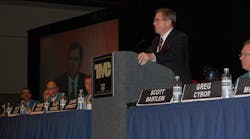In a speech given during the 2012 Technology & Maintenance Council annual meeting this week, Dan England – chairman and president of TL carrier C.R. England – stressed that obtaining better fuel economy must remain a critical core strategy for the trucking industry going forward, and that carriers should devote resources to keep improving it.
“We conduct ongoing, regular SAE Type 4 fuel testing within our fleet,” said England, who is also the current chairman of the American Trucking Assns. “We incur significant cost to do this, and take numerous steps to improve fuel [economy] performance, but we realize high benefit from it.”
C.R. England – a largely refrigerated carrier based in Salt Lake City, UT, started by England’s grandfather Chester in the 1920s – today operates a fleet of 4,336 trucks made up predominantly of Freightliner-branded Class 8 equipment, which includes 1,644 company units, 2,287 leased units, 202 trucks under lease-purchase agreements with owner-operators, as well as 233 independents under contract.
England noted in his speech that his fleet has managed to improve its aggregate fuel efficiency though a myriad of efforts by over 7/10th of a gallon per mile during the last four years, with average fuel economy going from 5.992 mpg (mpg) in 2008 to 6.760 mpg in 2011.
“We’re very pleased with this progress because we run very heavy and often in the mountains,” England explained. “We’ve managed this because we regularly review the mpg performance of our fleet.”
The company’s ongoing fuel economy testing covers a wide breadth of factors, he added, with the results directly influencing everything from equipment purchasing decisions to how C.R. England trains the drivers produced by the five trucking schools it owns and operates.
England noted the fleet’s mpg testing has compared tire types and brands; selective catalytic reduction (SCR) system vs. advanced exhaust gas recirculation (EGR) technology; 2010 model engines vs. 2007 models; automated mechanical transmissions (AMTs) vs. manual transmissions; and even measured the impact of equipment age on fuel economy, to name just a few.
To date, England’s testing has determined that SCR-equipped engines – which make up 1,765 of the power plants in its fleet – offer 3 to 3.5% better fuel economy. However, that improvement is not enough to offset the added cost of the diesel exhaust fluid or DEF that’s required to be sprayed into the exhaust stream to nullify oxide of nitrogen (NOx) emissions.
“We calculate we need a further fuel economy improvement of 1.5% to offset the extra cost of the DEF,” England said. “We’re not there yet, but we will be.”
Equipment decisions driven by the fleet’s fuel economy testing run a wide gamut as well – but not always for the reasons many fleets might think.
For example, take the Michelin X-One wide-base tires C.R. England specs for its trailer and tractor tandem drive axles. “We found the fuel economy benefit from these tires was wiped out by their higher cost,” England said.
However, the weight reduction offered by wide tires helped offset the extra poundage added by the extra emissions components of 2010-compliant SCR engines. “That weight reduction tipped the tires over the edge” into positive value territory, he explained.
By contrast, aerodynamic trailer fairings and auxiliary heating systems, which reduced engine idling, provided more direct fuel savings. “Trailer fairings provided a big return on the investment, no doubt about it, with a 2 to 3% benefit in our case,” England said.
The company also lowered its vehicle speeds to 62 mph for its company trucks and to 65 mph for contracted vehicles also due to a direct correlation with fuel savings extrapolated from its testing program. It also found that it could extend its tractor trade cycle out to four years versus a more typical three in the past and not compromise its fuel economy performance.
However, AMTs didn’t make the cut despite showing a 1.3% fuel economy benefit versus their manual brethren. “Right now, that’s not enough of a fuel benefit to justify the additional cost of such transmissions, nor were we getting the residual value from them,” England said. “However, we believe we will and should change in the future.”
In short, while the fleet’s fuel performance testing effort hasn’t uncovered what England calls a “magic elixir” to boost fuel economy, it allows the carrier to make in his words “much more informed decisions” on equipment selection and spec’ing decisions.
“We’ve found a big difference at times between the fuel savings claimed by a certain product or technology, and what it actually delivers,” he said. “That’s been one of the biggest benefits to our testing program.”



